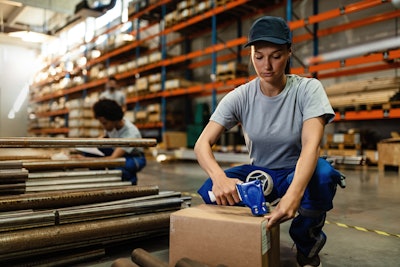
Even before the emergence of the Coronavirus disease (COVID-19), the supply chain was rapidly changing, shaped in part by the growth of e-commerce. With the pandemic, several important trends emerged that greatly impacted supply chains and the warehouses that play a crucial role within them. What makes these trends particularly notable is that they will continue to impact organizations across industries for the foreseeable future.
E-commerce adoption accelerated dramatically. Consumers naturally embraced e-commerce as a way to decrease their exposure to COVID-19 and adoption increased at unprecedented rates during the pandemic. Today, online purchases represent 20% of all retail sales.
Recent events highlight two related and important nuances that dramatically impacted supply chain operations. First, e-commerce rates were high even in industries where adoption levels were previously low. The grocery industry is one example. Prior to the pandemic, online grocery shopping was nascent outside of a few densely populated urban areas.
The Brick Meets Click/Mercatus Grocery Shopping Survey found that in September 2021, approximately 64 million U.S. households bought groceries online. That’s roughly half of U.S. households. Just as importantly, the same survey found that the number of people who bought groceries online in October eclipsed the total number of households that had placed a grocery order during the entire year from September 2018 to August 2019. That pace of adoption is unprecedented.
Secondly, consumers made it clear they are comfortable being and remaining hybrid shoppers that use multiple channels. In the second quarter of 2021, e-commerce rates increased 9.1% from the same period in 2020, according to U.S. Department of Commerce estimates. This was even as consumers flocked back to stores and total retail sales climbed 28% as vaccination rates rose.
Warehouses continued to evolve from manual to automated operations. The events of the past year established not only that consumers are buying more, but they want to do so on their terms, with many opting for same-day deliveries or same-day, in-store pickup. Consumers also want more choices – a reality that requires retailers to offer more SKUs if they want to effectively compete with e-commerce powerhouses.
Both developments necessitate more localized warehouses and facilities that operate at a faster velocity. For most, this transition necessitates automated systems that are capable of handling an exponential increase in materials, while doing so much faster, with the same number of people to achieve the tighter fulfillment windows consumers now demand. For this reason, the evolution of warehouses from manual to automated operations will only grow.
Notably, the systems used will also steadily be standardized as the industry moves toward the common data models needed to realize the full potential of artificial intelligence, machine learning and analytics. Organizations will look for the faster and more predictable deployments and costs associated with productized solutions, rather than bespoke warehouse systems that can take years to deploy.
These demands will force many organizations to significantly change the very framework of their materials handling and warehouse operations. In the new hyper-localized landscape associated with same-day deliveries, few systems that were effective pre-pandemic will be sufficient. Faster throughput will also compel many warehouse operators to increase storage density – another challenge that automation helps solve.
Labor challenges will continue. According to statistics gathered by the Bureau of Labor Statistics, 4.4 million Americans left their jobs in September 2021, more than ever before – narrowly edging out the previous month, when 4.3 million Americans quit. The labor challenge impacts nearly every aspect of the supply chain in North America, including manufacturing, distribution, fulfillment and delivery.
The delay of more than 80 container ships in late October at the ports in Los Angeles and Long Beach, caused in part by a shortage of warehouse workers and truck drivers, is just one example. Demographic shifts are partly to consider. In an update on the driver shortage in 2021, the American Trucking Associations predicted that up to 400,000 new drivers could be needed between now and 2030 as a result of drivers’ retirements.
The scope of the current labor challenge marks a significant and worrisome development, but the difficulty of attracting and retaining skilled workers is not a new issue. Many managers of warehouse operations, for example, find that it’s difficult to retain skilled employees even when they offer highly competitive wages and benefits. Repetitive and physically demanding work is often to blame. The current labor market only means that retaining employees – a challenge that logistics and warehouse operations are already accustomed to – will be even more important this year.
Increased adoption of robotic and software solutions. The Association for Advancing Automation announced that sales of robots last quarter were the best ever recorded, with nearly 29,000 being sold in 2021 as of Nov. 12, 2021.
This trend will continue, and notably robotic picking will increase dramatically this year as new technologies now enable robots to “see” the products they are pulling, more effectively than ever before. Software adoption will also continue to gain popularity as warehouse managers move to sequence and prioritize their orders to enhance efficiency and reward loyal customers with even faster fulfillment times.
In all cases, warehouse operations will demand robots and software solutions that are agile, flexible and can be adjusted for scale and capacity as needed. The pandemic provided a stark reminder that we never know what’s coming next.
Demand for sustainability. The demand for earth-friendly practices will continue to impact supply chains. Many companies are moving to remove plastics from their packaging and there is a sustained effort to ensure that only environmentally friendly materials are used in products. For example, companies in the European Union must submit data to the SCIP, the database for information on substances of high concern.
Consumers are also motivated. In its report, “Meet the 2020 Consumers Driving Change,” IBM and the National Retail Federation found that 57% of consumers are willing to change their buying habits to lessen environmental impact. Already, 65% of the world’s GDP is now committed to achieving a net zero carbon footprint in less than 30 years.
Additionally, there is a move toward circular solutions across supply chains that are more environmentally friendly and economical. For warehouse operations, this will increasingly require the move towards materials handling and fulfillment systems that are made using sustainable materials and designed for durability, easy disassembly and recycling.
The challenges of the past year that affected most industries’ supply chains will not disappear overnight. However, the industry has adopted a new, faster pace of embracing innovative solutions. For many companies, this has created a more resilient framework for meeting customer needs and mitigating disruptions. For those, the year ahead will be demanding, but 2021 prepared them well to tackle the challenges on the horizon.




![Pros To Know 2026 [color]](https://img.sdcexec.com/mindful/acbm/workspaces/default/uploads/2025/08/prostoknow-2026-color.mduFvhpgMk.png?auto=format%2Ccompress&bg=fff&fill-color=fff&fit=fill&h=100&q=70&w=100)







![Pros To Know 2026 [color]](https://img.sdcexec.com/mindful/acbm/workspaces/default/uploads/2025/08/prostoknow-2026-color.mduFvhpgMk.png?ar=16%3A9&auto=format%2Ccompress&bg=fff&fill-color=fff&fit=fill&h=135&q=70&w=240)






